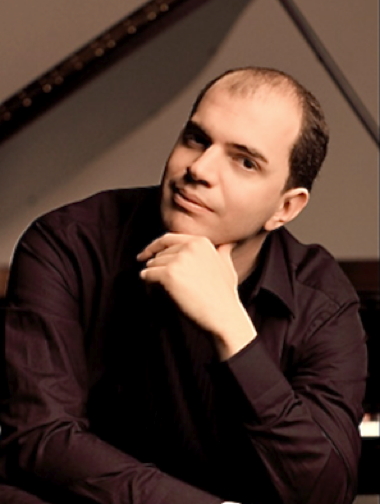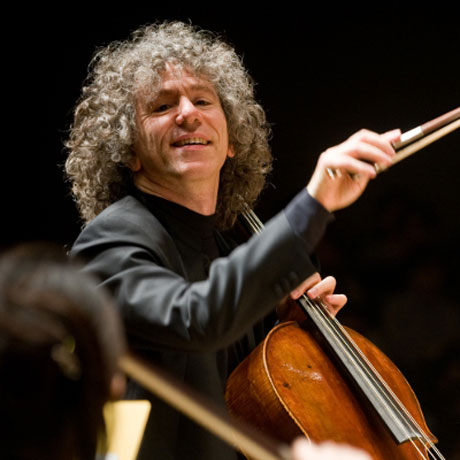Back to Brahms: Steven Isserlis to revisit a favorite and explore new works at Mandel Hall
In 1984, a 25-year-old cellist named Steven Isserlis recorded his first album, the two Brahms cello sonatas with pianist Peter Evans. Twenty-one years later, he recorded the sonatas again, this time with Stephen Hough.
“It’s like a friend,” said Isserlis of the Brahms sonatas. “The better you know them, the closer you can get to them.”
When asked how his playing has evolved between the two Brahms recordings, Isserlis paused to reflect. “It just happens,” he said, in a phone interview. “It’s like how you don’t recognize wrinkles coming into your face, but suddenly they’re there. If you see a photo of yourself twenty years ago you’re a bit shocked.”
This month and next, Isserlis will embark on a U.S. tour, returning to the Brahms sonatas once again, this time with pianist Kirill Gerstein. The tour will take the duo to Mandel Hall Friday night in an event for the University of Chicago Presents.
The British cellist, 54, has enjoyed a long and distinguished career since that first Brahms disc over a quarter-century ago. He has recorded over a dozen albums, ranging from the standard — a well-acclaimed recording of the Bach cello suites – to the lesser known, a disc called “reVisions,” with transcriptions by composer friends made at Isserlis’ request. In addition to his performing career, Isserlis is artistic director of the International Musicians Seminar Prussia Cove, and has written two children’s books, Why Beethoven Threw the Stew and its sequel, Why Handel Waggled his Wig.
On his current tour, Isserlis will bring his head of unruly curls and gut-string adorned cello to several cities including New York, Chicago, Cleveland and the Washington, D.C. area. Along with the Brahms sonatas, other pieces on his upcoming program include two other old friends – a pair of songs by Liszt, and Busoni’s Kultaselle, Variations on a Finnish Folksong – and a new addition to Isserlis’ repertoire, Bartók’s first rhapsody for cello and piano.
Isserlis never listens to his old recordings, he said. But he hopes that the Brahms sonatas have aged gracefully with him. “Hopefully they have 20 years’ more conviction and thought,” he said. “I’m slightly more analytical than I used to be.”
Some of this process has involved connecting themes from other Brahms’ works to the themes in the cello sonatas, For example, a theme in the first movement of the E minor sonata is similar to themes in an Intermezzo and a Ballade for piano. Finding similar thematic material in other works “corroborates” the atmosphere that Brahms is trying to create, Isserlis said.
The cellist has known the two Liszt pieces, Romance Oubliée and Die Zelle im Nonnenwerth, for quite a long time as well. “They are beautiful, curious, fascinating oddities,” said Isserlis. Both pieces are piano pieces and songs, although Liszt himself transcribed them for cello.
Isserlis first recorded the Liszt pieces with pianist Stephen Hough in 1995. Then, for his recent album, “Lieux retrouvés,” released last October, he took them into the studio again. The new album also includes two works by British composer and pianist Thomas Adès, and Adès plays the piano with Isserlis as well.
“The reason I recorded them with Thomas is he wanted them to be heard with his piece for cello,” Isserlis said. “He insisted we put the Liszt piece before, because they give an evocation of place.” The new album includes Adès’ Lieux retrouvés, or “Places Rediscovered,” in addition to works by Fauré, Janáček, Kurtág and Liszt. Adès says that these four composers were musical influences in writing his own work.
“It’s the hardest piece of music I’ve ever had to play,” says Isserlis, of the final movement of the Adès. “It is vicious. It’s racing around the cello, jumping larger distances, and there are harmonics that hardly exist.”He says he dreaded the recording session. “It’s still not perfect. But it goes by so fast it’s hard to tell.”
Although Isserlis won’t perform the Adès on the recital program with the Brahms, he does have plans to play it in the immediate future. On Feb. 3, Isserlis will play a family concert at the 92nd Street Y with pianist Jeremy Denk. He thinks the children will particularly enjoy the Adès because, unlike some of their adult companions, they lack prejudice against “new music.” “I think they’ll really like it,” he said. “Children are very nonjudgmental.”
As for the recital programs, in addition to the old friends of Brahms and Liszt, Isserlis will be presenting Bartók’s First Rhapsody for cello and piano. “Bartók is my new piece for the year 2012,” said Isserlis. “It still scares me a bit, actually. I wouldn’t learn it for years, partly because I have so many Hungarian friends who are passionate about Bartók. I didn’t want to get it wrong.” Part of the attraction – and difficulty – of Bartók is that he writes in such an individual language, said Isserlis.
His collaborator for these programs, pianist Kirill Gerstein, is an old friend as well. The two men met by chance, in Germany. Isserlis thought he would be playing with Russian violinist Kirill Troussov. But Gerstein showed up instead, and the pair soon became friends and musical collaborators. One of the pieces they played together on that first concert was the first Brahms sonata, said Gerstein.
“He is a super musician and very smart,” said Isserlis, of Gerstein. “He has a great brain.”

Gerstein, 33, said the two have a sort of father-son relationship. “I think our rehearsals are as much for rehearsing as for whining and quarreling and jokes, and both are essential to preparing for the concerts,” he said. “Steven stands at the intersection of many important meetings and people in my life,” said Gerstein, who met his wife through Isserlis.
Gerstein is particularly excited about revisiting the first Brahms sonata, and getting acquainted with the second. “I’ve wanted to play the two Brahms sonatas for quite some time. The second one we’ve never played together.” He is looking forward to the other works as well. “This is not just being polite,” he said. I’m really excited about all of it.”
As for Isserlis, while playing the Brahms with Gerstein is certainly exciting, there are other benefits to his upcoming U.S. tour as well. “I like Mexican food, which we don’t do here,” said Isserlis. “And I love margaritas. If you get a good one, it’s the best drink in the world.”
Isserlis and Gerstein will perform works by Brahms, Busoni, Liszt and Bartók 7:30 p.m. Friday at the University of Chicago’s Mandel Hall. 773-702-2787; chicagopresents.uchicago.edu/.
Corinne Ramey is a journalist and violist based in New York City. She has written for publications including NYTimes.com, Strad Magazine, Strings Magazine, WQXR.org, CityArts, The Forward and the NY Daily News. Originally from Dayton, Ohio, Cory holds degrees in comparative literature, viola performance and journalism from Oberlin College and Conservatory and Columbia University.
Posted in Articles



